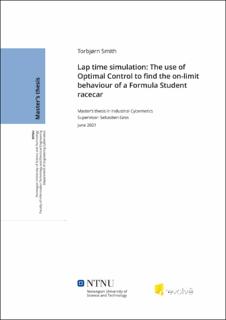| dc.contributor.advisor | Gros, Sebastien | |
| dc.contributor.author | Smith, Torbjørn | |
| dc.date.accessioned | 2021-11-09T18:21:01Z | |
| dc.date.available | 2021-11-09T18:21:01Z | |
| dc.date.issued | 2021 | |
| dc.identifier | no.ntnu:inspera:76427839:47745940 | |
| dc.identifier.uri | https://hdl.handle.net/11250/2828767 | |
| dc.description.abstract | Bildesign er en kompleks jobb, spesielt innen racing. Ingeniører bruker et bredt spekter av programvare for å bygge en racerbil som er så rask som mulig. Et slikt verktøy er rundetidssimulatoren. Rundetidssimulatoren gjør det ulig å simulere et helhetlig kjøretøydesign, noe som betyr at man simulerer at kjøretøyet kjører gjennom en bane og produserer en simulert rundetid. Målet er å simulere kjøretøyet, finne ytterpunktet av ytelsen, og produsere den minimale rundetiden kjøretøyet kan ha rundt en representativ bane.
I denne masteroppgaven blir en rundetidssimulator implementert for bruk hos Formula Student-laget Revolve NTNU. En fri bane, minimalt manøvreringsproblem blir definert som et optimal control problem, som skrives om til et ikke-lineært optimaliseringsproblem ved hjelp av en direkte ortogonal kollokasjonsmetode. Dette gjøres i MATLAB ved hjelp av rammeverket CasADi, og det resulterende ikke-lineære optimaliseringsproblemet løses ved hjelp av interior point-metoden med solveren Ipopt.
En plan, dobbeltsporet kjøretøymodell blir brukt for å oppnå god dekkmodellering, og det blir brukt sammen med en ikke-lineær dekkmodell. Kjøretøymodellen har også lastoverføring, aerodynamikk og drivlinjen modellert. Modellen av banen er generert ved å interpolere GNSS-koordinater som er målt under kjøring i Formula Student-konkurranser. Et optimal control problem blir brukt for å generere en jevn banekurvatur for simulatoren. Resultatene av simulatoren blir presentert og sammenlignet med telemetridata, og en annen rundetidssimulator som bygger på en quasi steady state metode. To kjøretøydesign blir også sammenlignet.
Simulatoren ble vist til å være en god representasjon av det virkelige kjøretøyet, og med en høyere beregningskostnad enn QSS-simulatoren, gir den en mer nøyaktig beskrivelse av dynamikken til et ekte kjøretøy. | |
| dc.description.abstract | Automotive design and engineering is a complex endeavor. Especially in racing. Engineers need to deploy a wide range of software tools to build the fastest racecar possible. One such tool is the lap time simulator. The lap time simulator allows a holistic simulation of a vehicle design, meaning the entire vehicle is simulated driving around a track, producing a simulated lap time. The goal is to simulate the vehicle and find the limit of performance, producing the minimum lap time the vehicle is capable of around a representative track.
In this thesis, a lap time simulator is implemented for use at the Formula Student team Revolve NTNU. A free trajectory, minimum time maneuvering problem is defined as an optimal control problem, that is transcribed into a nonlinear programming problem using a direct orthogonal collocation method. The transcription is done in MATLAB using the open-source software framework CasADi, and the resulting NLP is solved using the interior point method with the solver Ipopt.
A planar, double-track vehicle model is deployed for proper tire slip modeling, utilized in a nonlinear tire model. The vehicle model also has load transfer, aerodynamics, and the powertrain modeled. The track model is generated from interpolating GNSS coordinates recorded at Formula Student competitions, creating a curvilinear abscissa. An optimal control scheme is deployed to generate a smooth abscissa curvature for the minimum time maneuvering problem. The results of the simulator are presented and compared to telemetry data, a different lap time simulator using the quasi steady state methodology, and two vehicle designs are compared.
The simulator was shown to be an accurate representation of the real vehicle, and at a higher computational cost, it yields a more accurate description of the vehicle dynamics of a real vehicle than the QSS simulator. | |
| dc.language | eng | |
| dc.publisher | NTNU | |
| dc.title | Lap time simulation: The use of Optimal Control to find the on-limit behaviour of a Formula Student racecar | |
| dc.type | Master thesis | |
